Shop Diamond Jewelry Gifts for Mother’s Day
Why should you get your Mom diamond jewelry for Mother’s Day? Diamonds are appreciated for their clarity and brilliance. In much the same way, great mothers offer their children clarity…
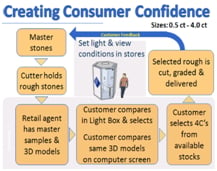 The Next Diamond™ cycle |
Abstract: Next Diamond™ enables diamonds to be cut and polished in a way that solves problems for diamond cutters, retailers and consumers. Consumers can actually see the shape and quality of the diamond that appeals to them, personally, and the rough diamond will only be cut after being selected as the preferred diamond.
By harnessing modern technology and web based communications we improve efficiency, cut quality and, best of all, allow individual taste to be satisfied. |
|||||||||||||||||||||||||||||||||||||||||||||||||||||||||||||||||||||||||
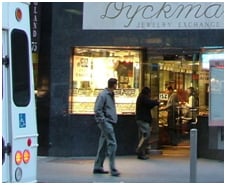 The lights in many jewelry stores are so bright that even poorly cut diamonds can look beautiful. Lighting varies from store to store making diamond comparison impossible. |
The problems: Mass market consumers rarely feel confident buying diamonds. Up-market clients often prefer custom made jewelry set with diamonds of superior quality and light performance; but they usually must accept generic rather than distinctive diamond cuts and shapes. Retailers face pressure to hold a large diamond selection and this leads to a slow stock turn and the need for high margins to get a good return on investment.
At first glance consumers seem to be blessed with an enormous choice of quality and prices, but this is mainly based on the natural 3 C’s (Carat, Color and Clarity). Quality and pricing is jargon based and opaque; buyers are often afraid of being ripped off. Shopping for large diamonds is neither relaxing, nor fun, and offers no self-realization experience. |
|||||||||||||||||||||||||||||||||||||||||||||||||||||||||||||||||||||||||
|
The diamond buyer’s nightmare
Diamond shoppers on the Internet and in stores often make large purchase decisions based mainly on complex technical specifications. For example: Is the one that costs 26% more actually better? Is Very Good Polish & Excellent Symmetry better than Excellent Polish & Very Good Symmetry? What does 1% difference in Diameter or Girdle thickness or the Table size mean? Will the more expensive stone sparkle more and look better? Enough to justify an extra $1,478? Would I see a difference if I saw the two stones side by side? How are they priced compared to ‘market values’? Neither diamond has a brand name (less than 10% of polished diamonds have a brand or manufacturers name). Some jewelry brands indirectly provide an endorsement, but no clear guarantee; are Harry Winston diamonds better than Cartier diamonds? Who knows? What about a ‘test-drive’? Can we put each diamond side by side in the same lighting conditions in the same shop? What would be their relative performance? How would they sparkle in a restaurant, on the golf course, on the red carpet, etc? Diamonds are shrouded in mystery. Other luxury products deliver more pleasure at each stage of acquisition and ownership: comparing, choosing, customising, talking about, and comparing with friends products, dreaming about the next purchase, my exclusive item, i.e. “IT FITS ME, I LOVE IT!” |
|||||||||||||||||||||||||||||||||||||||||||||||||||||||||||||||||||||||||
What would help you feel confident and justify such a dramatic price difference? Knowing they are Hyundai and Mercedes would help? “Yes, very useful” Brand names help us understand meaningful benefits like safety, reliability, operating cost, technical advancement, prestige, affordability, etc. Even if you are not familiar with a particular model they can all be compared with the help of market reviews, ratings and test results. It is easy to establish a short list – without even leaving home or work. Would you rely solely on reviewers opinions? “Are the seats comfortable? What’s it like to drive?”The test drive is the car markets solution; “drive both cars and compare them – see if it speaks to me”. |
||||||||||||||||||||||||||||||||||||||||||||||||||||||||||||||||||||||||||
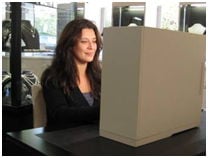  Test drive diamonds mounted in movable settings and all facing to the same point for easy comparison of any different cut.Examples of stones seen on the computer monitor. |
The Next Diamond™ Alternative
Next Diamond™ supplies each participating retailer and manufacturer with a Light Box and 10 different polished diamond samples. These always include an ASG0 H&A round, an AGS0 princess and 5 fancy cuts plus 3 of the latest new cuts that may be different from store to store. Consumers compare the master samples in the Light Box under different lighting environments and order a custom cut diamond. The lighting has various settings enabling small differences in brightness, fire and dead or dark zones can be easily distinguished. Beside the Light Box is a computer connected to the internet that runs a short introductory tutorial showing the actual sample stones on the screen. By studying the photo-real images of the stores 10 samples on screen the consumer learns to relate the real diamonds in the Light Box with the sample stone images. Inclusions are pointed out and differences in color and clarity are demonstrated. The resulting cost differences are explained transparently with the Next Diamond Pricelist™. Other available cuts from a library of 100 designs are offered for custom ordering. The buyer can select the cut, size and quality that fit his or her budget from the set pricelist. The retailer logs the request with Next Diamond™ and a match is made, a deposit is paid, and the manufacturer polishes the diamond. If there is no exact match a small selection of the closest quality stones’ is emailed to the store and to the consumer. The diamond will be graded and delivered to the retailer within 4 weeks and after approval by the retailer and consumer the final amount is handed over and the transaction completed. |
|||||||||||||||||||||||||||||||||||||||||||||||||||||||||||||||||||||||||
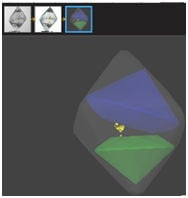 The emailed rough diamond planning file can be turned by the customer to see how the cutter will avoid the inclusions to achieve his diamond’s chosen clarity. |
||||||||||||||||||||||||||||||||||||||||||||||||||||||||||||||||||||||||||
| Key consumer problems solved by Next Diamond™
1. The visual comparison of different diamonds is inconvenient or impossible. The best way to compare any two items is to put them side by side and to look from the different directions; 2 paintings can be hung side by side in an art gallery. This comparison can be very difficult to do with loose diamonds. Jewelers may place the stones being compared between two fingers on the back of your hand. The diamonds are rarely perfectly ‘face up’ and often slip about; the resulting preference could be the opposite in a repeat of the test. Body oils from the fingers can lead to the diamonds becoming dirty spoiling the results. Next Diamond™ uses a Light Box with holders that fix all the diamonds in the face up position and rock them. 2. It is impossible to ‘test-drive’ diamonds Jewelry store lighting can mislead a buyer without giving any idea how the diamond will perform in other lighting or even in another jewelry store! Next Diamond™ shops all have the same Light Box which models various types of lighting to help assess the performance of a diamond in various environments’. 3. It is impossible to compare fancy cut performance with known standards The few existing standards for cut quality use different scales to compare different fancy cuts. None compare them to known standards like the Tolkowsky round brilliant. Next Diamond™ is based on visual comparison with traditional industry standards like an AGS0 round and princess cut – all the samples have the same visual spread. 4. Fancy cut inconsistency Currently when a consumer sees a fancy cut in a store and orders one in an alternative size or quality, the stone supplied has a different appearance. Generic fancies are often cut to different models by different manufacturers and they are even mixed together in the same parcel. The lack of industry standards and different models from producers ensure little or no chance ordered stones will match the appearance of the original sample. Next Diamond™ ensures the manufacturer is known. All follow the agreed best standards for the sample fancy cut stones. The same performance is repeated every time in whatever color, clarity and size that is requested. 5. Quality and pricing is opaque and based on too much jargon In Next Diamond™ shops consumers’ study both the real stones and enlarged computer photo-realistic image and they learn the key quality factors. Inclusions and differences in color are pointed out and cost differences are explained transparently with the Next Diamond Pricelist™. |
||||||||||||||||||||||||||||||||||||||||||||||||||||||||||||||||||||||||||
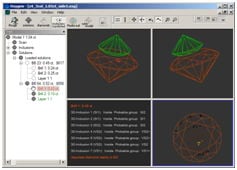 The image above shows the planning process that often leads to several options.Values can be within 10% of each other as shown in this example:
|
Manufacturing:
There are many manufacturers capable of cutting and polishing diamonds to the very high standards required to satisfy Next Diamond™ buyers’ orders. Manufacturers have or will acquire the technology needed for this project. Next Diamond’s Pricelist™ offers consumers transparentpricing for the first time and also ensures that retailers and manufacturers margins are upheld; manufacturers will compete for orders based on selection, quality and service. The list will be adjusted from time to time to reduce the price of cuts that are in poor demand. Once a consumer order is received data-based technology matches it to the available diamonds from many participating manufacturers. There is an incentive for manufacturers to hold a wide selection of available pre planned rough since if there is only one available stone with a perfect match then that manufacturer wins the business. If there is no perfect fit the closest diamonds will be selected. If two or more manufacturers have a perfect match the order goes to the one with the highest ranking based on open rules: · The shortest reliable delivery time · The best record for cut quality control · The best record for accurate carat weight, clarity and color production Rough Holding If 10 manufactures each held only 100 rough stones with 10 promising plans then 10,000 virtual diamonds with their colour and clarity 3D models would be available for consumers to select from in their local store. If 100 retailers each sold one diamond every trading day the manufacturers would achieve an average 20 stock turns PA and receive immediate payment and a good margin. Naturally they would then hold back even more rough from their regular current business. |
|||||||||||||||||||||||||||||||||||||||||||||||||||||||||||||||||||||||||
| Cut Designers will be paid directly by manufacturers based on direct negotiations. If a designer or manufacturer elects they may use the intellectual property paid protection services offered by OctoNus and the Cut Group. For the first time we expect to see the profession of diamond designers evolve. | ||||||||||||||||||||||||||||||||||||||||||||||||||||||||||||||||||||||||||
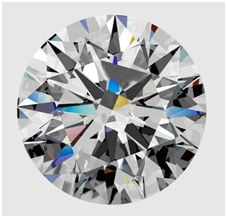 A computer render of a diamond showing its inclusions. 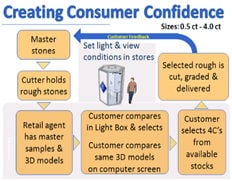 The flow chart process takes around 4 weeks. |
Grading and Final Price Variations
A third party grading lab will confirm the inclusions and if required it will re-plot them in OctoNus Helium Polish and Mbox. A grading report will be issued and the stone is laser inscribed. Next Diamond™ will audit the lab focusing on cut quality. After payment and receipt of the diamond the consumer has the right at any time within 30 days to send the diamond to any lab at their own cost. Real consumer confidence will be assured as Next Diamond itself will guarantee grades and services. If the final polished diamonds colour and clarity grade varies by one grade lower from the planned estimate Next Diamond will make a refund against the open pricelist. For 2 grades lower a penalty refund of double the grade difference will be made. If the polish or symmetry grades fall below Very Good a price reduction will result on each count or the consumer may reject the stone and start again. Most rejection decisions will be made before the diamond is shipped based on the grading report and the final Gem Adviser Inclusion model which will be emailed to both the retailer and the consumer. If the diamond has a lower weight within a price category the consumer should accept the stone with a proportional price adjustment. If the weight category drops (from say 1.00ct to 0.99ct) the consumer may reject the stone and start again, or keep it at the much lower price against the list. |
|||||||||||||||||||||||||||||||||||||||||||||||||||||||||||||||||||||||||